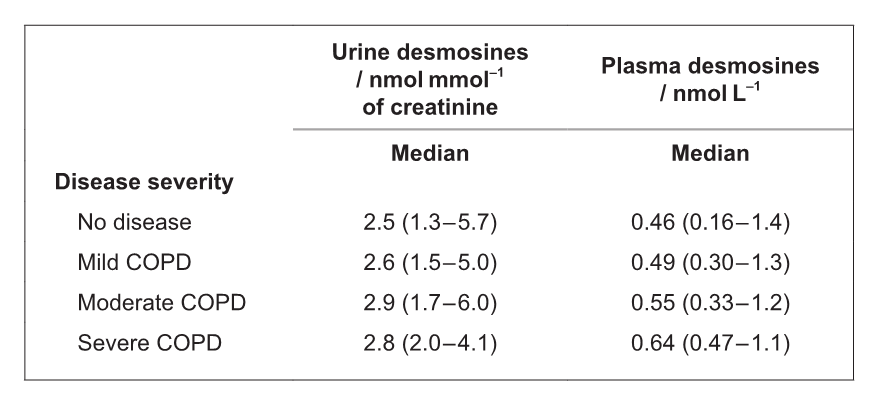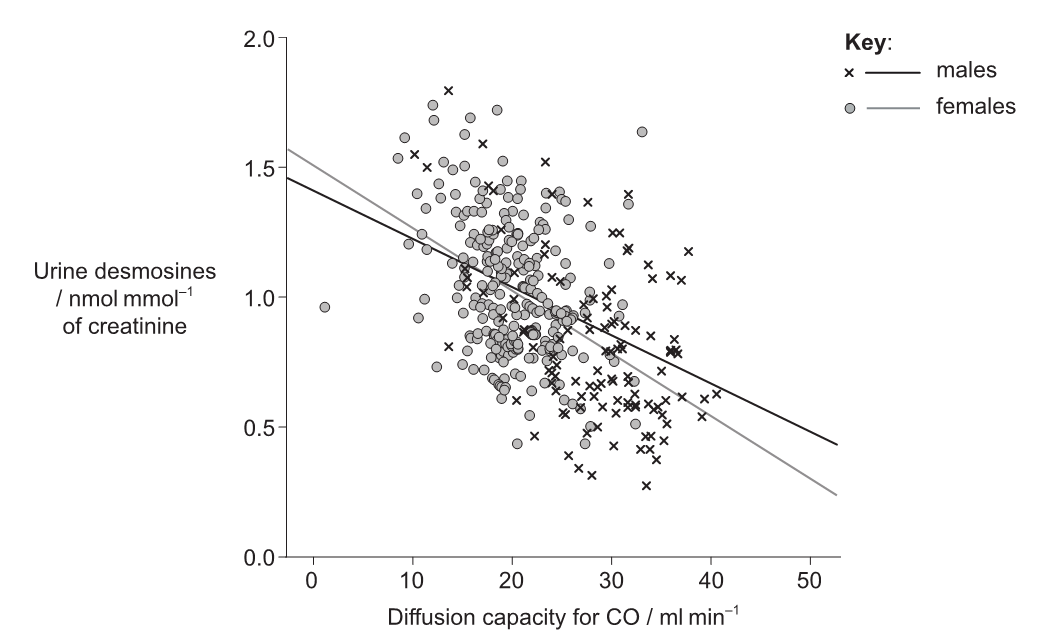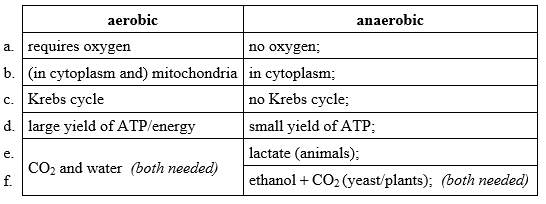Question
Chronic Obstructive Pulmonary Disease (COPD) is characterized by progressive airflow limitation. Classification of COPD as mild, moderate or severe is based on measurement of Forced Expiratory Volume (FEV), which is the maximum volume of air that can be exhaled in one second.
The table shows the numbers of individuals in each COPD class and their mean FEV for a Swedish study of 349 people.

[Source: Reproduced with permission of the © ERS 2012. European Respiratory Journal Apr 2012, 39 (4) 839–845; DOI: 10.1183/09031936.00064611]
The elasticity and resilience of the lungs are mainly provided by the protein elastin. Degradation of elastin produces peptides called desmosines.
Desmosines in urine or blood plasma have been proposed as biomarkers of lung degradation. The relationship between urine desmosines, plasma desmosines and COPD severity in patients was assessed.

[Source: Reproduced with permission of the © ERS 2012. European Respiratory Journal Apr 2012, 39 (4) 839–845; DOI: 10.1183/09031936.00064611]
The graph shows the relationship between the diffusion capacity of the lungs for carbon monoxide (CO) and urine desmosines.

[Source: Reproduced with permission of the © ERS 2012. European Respiratory Journal Apr 2012, 39 (4) 839–845; DOI: 10.1183/09031936.00064611]
State the level of COPD that has the lowest FEV.
Explain how a low FEV can be used to indicate emphysema.
State the disease severity group that has the highest range of plasma desmosines.
Evaluate which of the two biomarkers would be the most useful indicator of COPD severity.
Elastin is also an important component of other tissues such as arteries and ligaments. Evaluate how these other sources of elastin could affect the interpretation of the biomarker as an indicator of COPD.
State the relationship between diffusion capacity and urine desmosines.
Other studies on pulmonary diseases have shown a wide variety of results. Apart from age, sex and severity of COPD, list two other factors that may explain the inconsistent results between studies.
Discuss whether measurements of desmosine concentration would be useful for monitoring changes in the health of a patient.
▶️Answer/Explanation
Markscheme
Severe
a. low FEV indicates inability to force out air/adequate volume of air
OWTTE
b. airflow limitation is the reason for inability to force out air/shortness of breath
c. inability to force out air/shortness of breath indicates emphysema
d. emphysema causes/involves breakdown of alveoli walls «so less elastin»
The idea that there are fewer alveoli to “push”
[Max 2 Marks]
No disease
a. plasma desmosines
b. neither is very good due to large overlaps of ranges
OWTTE
OR
the range of data for each category is less for plasma desmosines
OR
data are more reliable
c. the level of plasma desmosines increases with disease severity
d. easier/less invasive to take urine sample rather than a plasma sample
[Max 2 Marks]
a. degradation of elastin from other tissues may have contributed to the results
b. there is no guarantee that the concentrations of desmosines measured came from the lungs
OR
difficult to assess how much lung elastin constitutes the total
c. overlapping ranges makes interpretation difficult
[Max 2 Marks]
inversely correlated
OR
negative correlation
OR
the higher the «urine» desmosine concentration, the lower the diffusion «rate»
a. «small» sample size
OR
only studied in one country
b. methods used
c. environment/pollution/workplace exposure
d. race/genetic factors
e. health status/fitness/BMI of volunteers
[Max 2 Marks]
a. positive correlation with COPD severity «as seen in the table»
OR
negative correlation with «CO» diffusion capacity «as seen in the graph»
b. not directly proportional/other factors affect it
c. «but» if other factors stay the same in a patient it could be an effective indicator of change
d. because the ranges are high, only change in an individual is useful
e. the measurements may be more useful for one gender than the other as differences seen in the graph
[Max 3 Marks]
Question
The human circulatory system is structured to serve the organs and tissues of the body efficiently.
Outline the exchange of materials between capillaries and tissues.
Explain the structures and functions of arteries and veins.
Describe what happens in alveoli.
▶️Answer/Explanation
Markscheme
a. molecules move by diffusion / move down a concentration gradient
b. nutrients move into tissues
c. gas exchange / Oxygen and carbon dioxide exchange between tissues and blood/capillaries
d. (nitrogenous) wastes/excess water move from cells/tissues into blood/capillaries
e. hormones leave capillaries in target tissues/to attach to receptors on cells / (endocrine) organs/gland tissues release hormones into the bloodstream
a. arteries and veins have three layers in their walls
OR
walls of arteries and veins have tunica externa, media and intima
b. pressure is high in arteries/pressure is low in veins
c. arteries receive blood from ventricles/heart / carry blood away from heart
d. lumen of artery is small to keep pressure high
e. arteries have thick (muscular) walls (with elastic fibres) to withstand pressure
f. elastic fibres recoil in response to ventricle/heart contraction
g. muscle / elastic fibres help maintain pressure between heartbeats
OR
muscle / elastic fibres help propel blood toward capillary beds
h. veins receive blood from capillaries/capillary beds / carry blood to heart
i. large lumen of veins so there is less resistance to blood flow
j. valves in veins keep blood flowing toward heart/prevent backflow
a. gas exchange
b. oxygen diffuses from air to blood and carbon dioxide diffuses from blood to air
c. oxygen binds to hemoglobin in red blood cells
d. pressure inside/volume of alveoli increases/decreases / air enters/exits alveoli during inspiration/expiration/ventilation
e. blood flow through capillaries / concentration gradients of gases/oxygen/CO2 maintained
f. type II pneumocytes secrete fluid/surfactant / secretion of surfactant to prevent sides of alveolus adhering
Accept answer in a clearly annotated diagram.
Question
State the functions of the following organelles of a eukaryotic animal cell: lysosome, Golgi apparatus, free ribosomes, plasma membrane, rough endoplasmic reticulum.
Distinguish between anaerobic and aerobic cell respiration in eukaryotes.
Explain the mechanism of ventilation in the lungs in order to promote gas exchange for cell respiration.
▶️Answer/Explanation
Markscheme
lysosome:
a. (from Golgi apparatus) with digestive enzymes / break down food/organelles/ cell;
Golgi apparatus:
b. site that processes/modifies/packages and releases proteins;
free ribosomes:
c. site of synthesis of proteins (released to cytoplasm);
plasma membrane:
d. controls entry and exit of materials/substances in cell;
rough endoplasmic reticulum:
e. synthesis and transport of proteins; (both needed)

Award [1] for each contrasting characteristic.
Table format is not necessary for the marks.
a. inspiration/inhalation brings air into lungs;
b. external intercostal muscles contract;
c. and move rib cage upwards and outwards;
d. diaphragm flattens/contracts;
e. increasing thoracic volume;
f. pressure decreases from atmospheric pressure so air rushes into lungs;
g. expiration/exhalation forces air out;
h. internal intercostal muscles contract / external intercostal muscles and diaphragm relax;
i. abdominal/abdomen wall muscles contract and push diaphragm upwards;
j. decreasing thoracic volume;
k. increasing pressure in lungs so air is forced out;
l. a concentration gradient between air sacs and blood needs to be maintained;